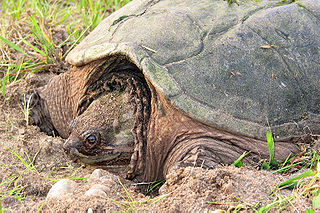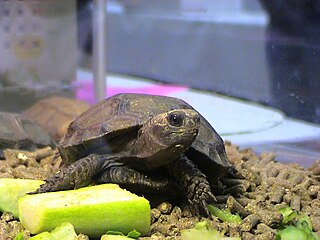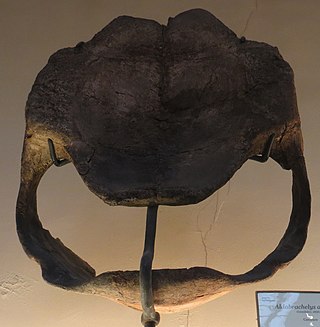
Tortoises are reptiles of the family Testudinidae of the order Testudines. Like other turtles, tortoises have a shell to protect from predation and other threats. The shell in tortoises is generally hard, and like other members of the suborder Cryptodira, they retract their necks and heads directly backward into the shell to protect them.

Giant tortoises are any of several species of various large land tortoises, which include a number of extinct species, as well as two extant species with multiple subspecies formerly common on the islands of the western Indian Ocean and on the Galápagos Islands.

The Chelydridae is a family of turtles that has seven extinct and two extant genera. The extant genera are the snapping turtles, Chelydra and Macrochelys. Both are endemic to the Western Hemisphere. The extinct genera are Acherontemys, Chelydrops, Chelydropsis, Emarginachelys, Macrocephalochelys, Planiplastron, and Protochelydra.

Chelodina, collectively known as snake-necked turtles, is a large and diverse genus of long-necked chelid turtles with a complicated nomenclatural history. Although in the past, Macrochelodina and Macrodiremys have been considered separate genera and prior to that all the same, they are now considered subgenera of the Chelodina, further Macrochelodina and Macrodiremys are now known to apply to the same species, hence Chelydera is used for the northern snake-necked turtles.

Chelydra is one of the two extant genera of the snapping turtle family, Chelydridae, the other being Macrochelys, the much larger alligator snapping turtle. The snapping turtles are native to the Americas, with Chelydra having three species, one in North America and two in Central America, one of which is also found in northwestern South America.

Elseya is a genus of large side-necked turtles, commonly known as Australian snapping turtles, in the family Chelidae. Species in the genus Elseya are found in river systems in northern and northeastern Australia and throughout the river systems of New Guinea. They are identified by the presence of alveolar ridges on the triturating surfaces of the mouth and the presence of a complex bridge strut.

Manouria is a genus of tortoises in the family Testudinidae. The genus was erected by John Edward Gray in 1854.

Hesperotestudo is an extinct genus of tortoise native to North and Central America from the Early Miocene to the Late Pleistocene. Species of Hesperotestudo varied widely in size, with a large undescribed specimen from the Late Pleistocene of El Salvador reaching 150 cm (4.9 ft) in carapace length, larger than that of extant giant tortoises. Historically considered a subgenus of Geochelone, it is now considered to be distantly related to that genus. Its relationships with other tortoises are uncertain. The exposed areas of the bodies of Hesperotestudo species were extensively covered with large dermal ossicles, which in life were covered in keratin. It has been suggested that species of Hesperotestudo were relatively tolerant of cold weather. Hesperotestudo became extinct at the end of the Pleistocene roughly co-incident with the arrival of the first humans in North America. There is apparently a site in Florida where one individual may have been killed that some suggested were evidence of butchering, although others suggested that the turtle was neither cooked nor does a ledge that was found near it date at the same time as it.

Chelonoidis is a genus of turtles in the tortoise family erected by Leopold Fitzinger in 1835. They are found in South America and the Galápagos Islands, and formerly had a wide distribution in the West Indies.

Aldabrachelys abrupta, the abrupt giant tortoise, is an extinct species of giant tortoise that was endemic to Madagascar.

Megalochelys is an extinct genus of tortoises that lived from the Miocene to Pleistocene. They are noted for their giant size, which is among the largest of any known testudine, with a maximum carapace length over 2 m (6.5 ft) in M. atlas. During the dry glacial periods it ranged from western India and Pakistan to as far east as Sulawesi and Timor in Indonesia, though the island specimens likely represent distinct species.

The Tenerife giant tortoise is an extinct species of cryptodire turtle in the family Testudinidae endemic to the island of Tenerife, in the Canary Islands.
The Gran Canaria giant tortoise is an extinct species of cryptodire turtle in the family Testudinidae endemic to the island of Gran Canaria, in the Canary Islands.

Centrochelys is a genus of tortoise. It contains one extant species and several extinct species:

Scott A. Thomson is an Australian herpetologist, paleontologist, and taxonomist, specialising in turtles of the family Chelidae.
Phrynops paranaensis is an extinct species of turtle from the Huayquerian Ituzaingó Formation of the Paraná Basin, Argentina, likely to be late Miocene in origin.
Chelonoidis alburyorum is an extinct species of giant tortoise that lived in the Lucayan Archipelago from the Late Pleistocene to around 1400 CE. The species was discovered and described by Richard Franz and Shelley E. Franz, the findings being published in 2009.

Solitudo is an extinct genus of tortoise that was found during the Pliocene and Pleistocene on the Mediterranean islands of Menorca, Malta and Sicily. The genus includes three described species, Solitudo robusta, Solitudo gymnesica and Solitudo sicula as well as a likely fourth, undescribed species from Monte Pellegrino in Sicily. Solitudo sicula, the youngest of the species, died out approximately 12.5 thousand years BP. The largest species, Solitudo gymnesica, has been estimated to have reached a carapace length of 1.1–1.3 m (3.6–4.3 ft).
Chelonoidis cubensis, also known as the Cuban giant tortoise, is an extinct species of land tortoise that lived in Cuba from the Late Pleistocene to the Early Holocene. It had a carapace length of between 40 cm and 90 cm. It is thought that the species went extinct through human exploitation.
Chelonoidis monensis, also known as the Mona tortoise, is an extinct species of land tortoise that lived on the island of Mona from the Late Pleistocene to around 1000 BCE. Evidence for the latter date includes cave drawings. All fossil remains have been found either in or near Liro Cave on the east side of Mona. It had a carapace length of around 50 cm.













